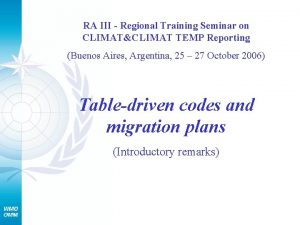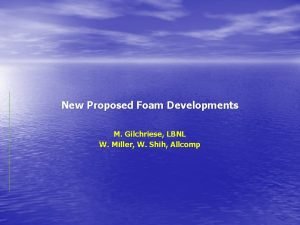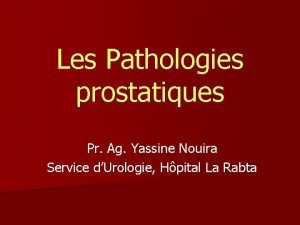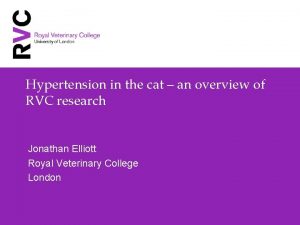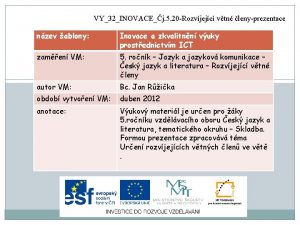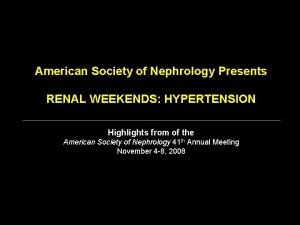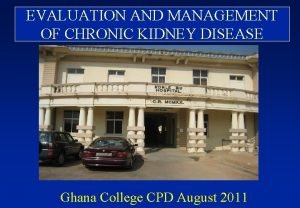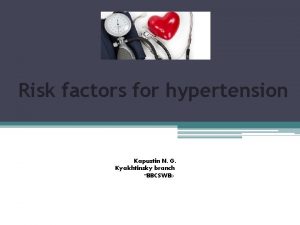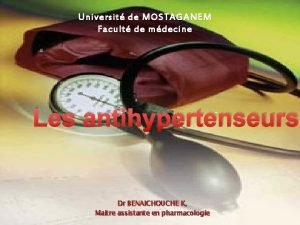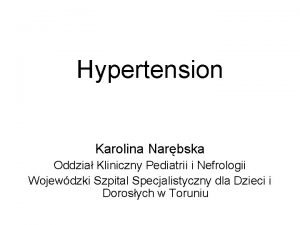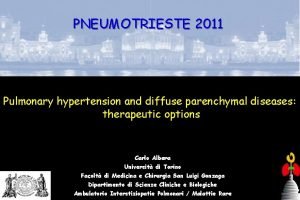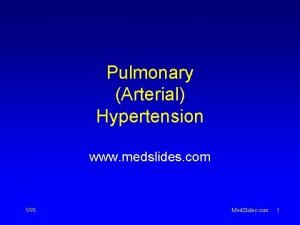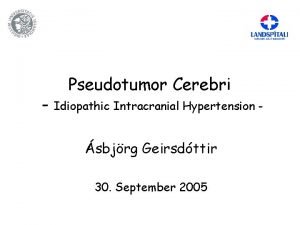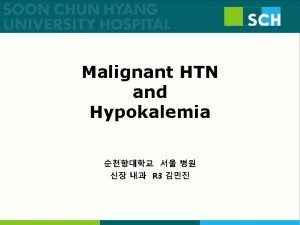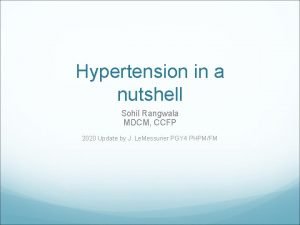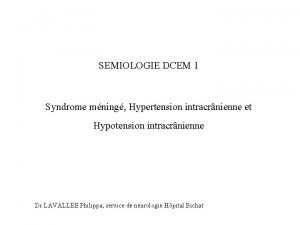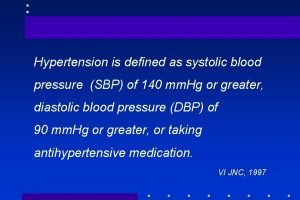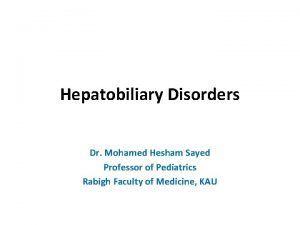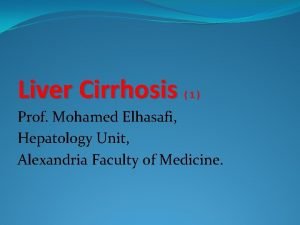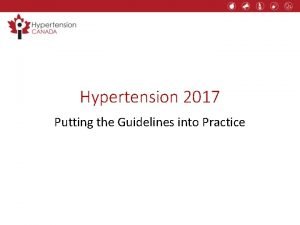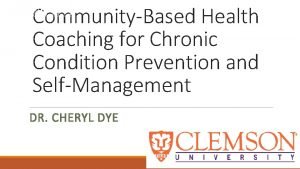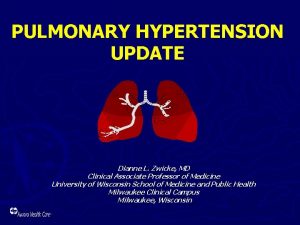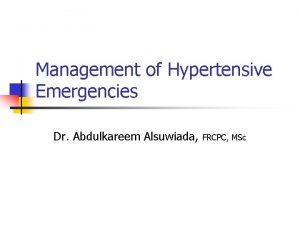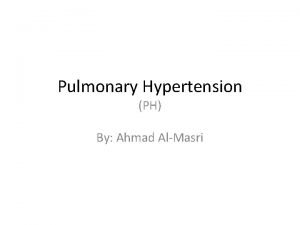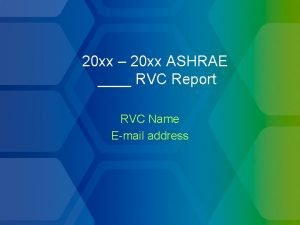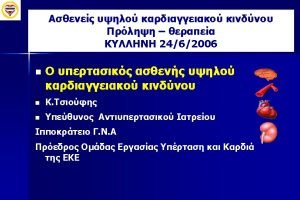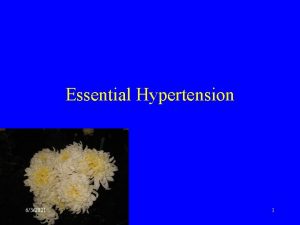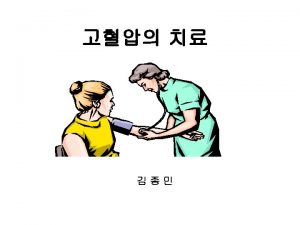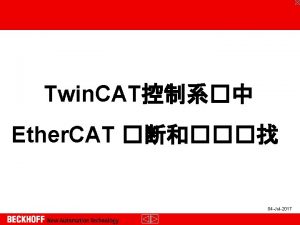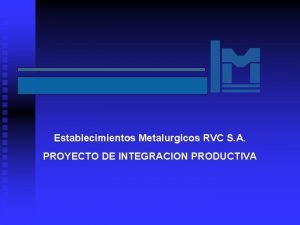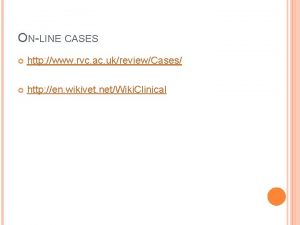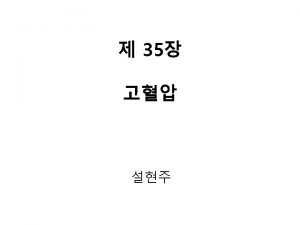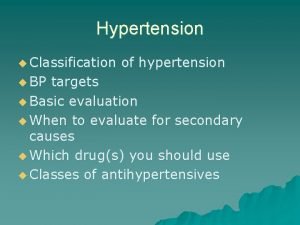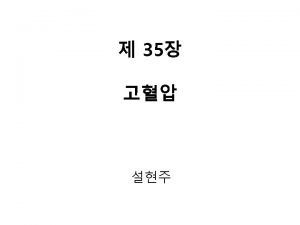Hypertension in the cat an overview of RVC



























![Is FGF-23 higher in hypertensive cats? FGF-23 § NT: 633 [344, 1507] pg/m. L Is FGF-23 higher in hypertensive cats? FGF-23 § NT: 633 [344, 1507] pg/m. L](https://slidetodoc.com/presentation_image/503fda0184cdf5c9f07300248f03c573/image-28.jpg)






- Slides: 34

Hypertension in the cat – an overview of RVC research Jonathan Elliott Royal Veterinary College London

Landmarks for feline hypertension research at the RVC • 1992 first BSAVA Clinical Studies Trust Fund grant awarded (Penney Barber appointed - Ph. D) • 1993 Measurement of ionised calcium using electrode methods – is low ionised calcium related to feline hypertension? • 1994 funding from Waltham Centre for Pet Nutrition (small contract for diet pilot study) • 1998 Harriet Syme appointed to Ph. D scholarship – to follow the observation that low potassium was linked to hypertension • 2005 Rosanne Jepson appointed to Ph. D to study early stage CKD and role of hypertension 2

Landmarks for feline hypertension research at the RVC • 2008 – Natalie Finch appointed – made the observation linking urinary cadmium excretion and hypertension • 2008 – Shubhro Chakrabarti examined the association between clinical factors and renal pathology in cats • 2011 – Rosanne Jepson re-joins the group following her residency training and started working on genetic factors in feline hypertension (ongoing) • 2012 – Esther Bijsmans appointed and studies blood pressure changes with time (longitudinal studies) and markers of hypertension and response to treatment • 2014 – Henk Van Den Broek appointed and identified a relationship between increased FGF-23 and hypertension • 2015 – Amlodipine licensed for use in the cat 3



What are the risk factors for hypertension in the cat? • Most reports of hypertension suggest it occurs most frequently in association with underlying disease • Chronic kidney disease • Hyperthyroidism • Hyperaldosteronism (Conn’s Syndrome) • Secondary to use of erythrocyte stimulating agents • • Idiopathic hypertension – unknown aetiology (represents 1 in 6 (c 18%) of hypertensive cats we see) blood pressure increases with age in cats as it does in people (their food contains too much sodium too!) 6

Blood pressure of healthy cats Age (yrs) • • Number SBP DBP MAP <1 17 123. 7 ± 11. 1 61. 6 ± 11. 6 82. 0 ± 12. 7 1 -3 13 122. 6 ± 11. 1 62. 6 ± 7. 4 83. 4 ± 8. 5 3 -5 13 127. 0 ± 16. 3 65. 3 ± 16. 1 86. 7 ± 18. 0 5 -7 11 129. 3 ± 17. 1 70. 4 ± 15. 4 90. 6 ± 17. 1 7 -11 12 127. 4 ± 14. 5 67. 6 ± 17. 5 88. 1 ± 17. 2 11 -14 16 158. 2 ± 33. 6 96. 7 ± 28. 8 120. 6 ± 32. 2 14 -16 16 162. 0 ± 22. 1 91. 9 ± 22. 6 117. 4 ± 24. 8 >16 6 179. 0 ± 25. 5 117. 5 ± 26. 5 139. 7 ± 27. 6 Cats aged 11 years or above had significantly higher pressure and a higher SD than those <11 yrs Only 60 of the 104 cats enrolled had their renal function assessed Most of these cats were from a colony kept for nutrition studies Prevalence of hypertension not defined Bodey & Sansom (1998) JSAP 39: 567 -573 7

Systolic blood pressure in healthy cats • • • 780 cats sampled at a re-homing centre All healthy on PE but no blood screening undertaken Other factors found to influence BP Ø Body condition score Ø Sex Ø Demeanour of cat Payne et al. , J Vet Intern Med. 2017 Jan; 31(1): 15 -21. 8

Prevalence of hypertension in healthy cats Jepson et al. , 2009 JVIM 23: 806– 813 • • 118 cats were screened – all assumed healthy by their owners 15 cats had SBP >170 mm. Hg (persistently (6) or associated with ocular lesions (9)) Median SBP was 139. 8 [125. 5, 163. 3] mm. Hg SBP in those cats that became azotaemic (n=29) within 12 months was 149. 2 [133. 6, 174. 2] vs. 136. 0 [124. 0, 150. 6] mm. Hg in those that were non-azotaemic (n=66) at 12 mth (P=0. 053)

Does SBP increase with age in the cat? • • • 133 normotensive healthy cats were recruited 124 of these cats remained normotensive for their follow-up period [666 (495, 1065) days]; systolic BP increased at a rate of 0. 4 ± 0. 1 mm. Hg/100 days 9 cats became hypertensive after a follow-up period of 939 (685, 1217) days SBP at recruitment was significantly higher in the cats that became hypertensive: • 131. 6 (115. 0, 143. 7) vs. 145. 6 (139. 5, 154) mm. Hg This study shows BP increases with age and a prehypertensive phase probably could be defined in cats (>140 mm. Hg) 10

Conclusions to studies in healthy cats • • • There are relatively few studies determining the prevalence of hypertension in cats This varies with age – most studies have involved relatively small populations of younger cats Once a cat is 10 years old, regularly checking its blood pressure would be the best way of identifying hypertension at an early stage c 13% of cats ≥ 10 years old will be hypertensive [Prevalence from Jepson et al. , 12. 7 (6. 7 -18. 7)%] Identification and treatment at an early stage could avoid target organ damage (brain, eye, heart, kidney) 11

Is systemic hypertension a factor in progression of CKD? l l Evidence from human medicine seems clear-cut Category ESRD RR BP Incid Elevations of BP 5 yr) (10 are a strong Optimal 5. 3 1. 0 120/80 independent risk Normal 6. 6 1. 2 129/84 factor for ESRD High normal 11. 1 1. 9 139/90 Klag et al. , 1996 NEJM, 334, 13 -18 Stage 1 Stage 2 Stage 3 Stage 4 21. 0 3. 1 43. 6 6. 0 96. 1 11. 2 187. 1 22. 1 159/100 179/110 209/120 210/120

Epidemiological study – feline CKD l l Enrolled 103 consecutive cases of CKD diagnosed at first opinion clinics in central London Excluded cases with: – Acute kidney injury – Any drug treatment that would lower BP l l Cats with concomitant suspected or confirmed hyperthyroidism were included Multivariable logistic regression was used to examine potential risk factors

Distribution of systolic blood pressure measurements in 103 cats with chronic renal failure Syme et al. , (2002) JAVMA, 220, 1799 -803

Age as a risk factor for hypertension in renal disease Syme et al. , (2002) JAVMA, 220, 1799 -803 Normotensive Hypertensive

Plasma creatinine concentration as a risk factor Syme et al. , (2002) JAVMA, 220, 1799 -803 Normotensive Hypertensive

Plasma potassium concentration as a risk factor * P=0. 02, logistic regression OR 0. 39 * Syme et al. , (2002) JAVMA, 220, 1799 -803

Blood pressure and mortality • • • SABP per se does not appear to be an independent factor influencing the survival of cats with CKD However, hypertension is significantly related to mild proteinuria in cats Proteinuria is a significant predictor of survival in the cat

Histopathology study Chakrabarti S et al. , Vet Pathol, 2013 Jan; 50(1): 147 -55 higher time-averaged systolic blood pressure was associated with glomerulosclerosis and hyperplastic arteriolosclerosis

Urinary albumin excretion in 136 cats with renal dysfunction and/ or hypertension 5 13 22 14 28 32 21 Syme et al. , 2003 JVIM, 17, 405

<0. 2 (49) 0. 2 -0. 4 (30) >0. 4 (29) Survival in days Jepson et al (2007) JVIM 21(3): 402 -9

Does Blood pressure increase over-time in CKD cats? • • 265 cats dx with CKD (Aug 2000 -2012) and seen for >3 months (longitudinal follow-up) 105 (39 [33 -45] %) were dx with concomitant hypertension (or hypertension dx within 3 mths) Higher prevalence than previous study Of the remaining 160 cats Ø 133 remained normotensive (follow-up 316 [225 -512] days); SBP 133. 2 [121. 2, 144. 6] mm. Hg; rate of change of SBP 0. 5 ± 0. 1 mm. Hg/100 days Ø 27 (17%) became hypertensive (median follow-up 379 [281 -771] days); SBP 147. 2 [140. 4 , 156. 1] mm. Hg; rate of change of SBP 1. 1 ± 0. 3 mm. Hg/100 days; 13 of these cats had retinal lesions at dx of hypertension Bijsmans et al. , (2015) JVIM 29: 855– 861

Development of hypertension over time Bijsmans et al. , (2015) JVIM 29: 855– 861 Cox’s proportional hazards ratio: 0. 2 (0. 08 – 0. 36) – P<0. 001)

Conclusions • • • Cats with CKD are at a 2 to 3 fold higher risk of being hypertensive vs. healthy cats of similar age Normotensive CKD feline patients are 5 times more likely to develop a blood pressure where treatment is needed to prevent target organ damage than are healthy cats A pre-hypertensive stage could be proposed for cats with CKD (140 -150 mm. Hg) Does starting antihypertensive interventions at an early stage prevent severe hypertension developing? What would this do to progression of CKD? 24

Classification of feline hypertension Systolic blood pressure (mm Hg) <150 Diastolic blood pressure (mm Hg) <95 Risk of future target organ damage Minimal BP substage Original New AP 0 Normotensive 150 - 159 95 - 99 Mild AP 1 160 - 179 100 - 119 Moderate AP 2 Borderline hypertensive Hypertensive >180 >120 Severe AP 3 Severely hypertensive International Renal Interest Society 2015 (based on ACVIM Consensus statement 2007) Professor Harriet Syme and Dr Rosanne Jepson are part of the ACVIM consensus group working on a new Hypertension consensus statement 25

Evaluation of RAAS in hypertensive cats Jepson et al. , (2014) J Vet Intern Med; 28(1): 144 -53 26

Effect of amlodipine treatment on RAAS Plasma aldosterone concentration did not change Ø pre 122. 8 pg/ml [92. 3, 162. 4], post 108. 4 pg/ml [57. 1, 176. 5] Plasma renin activity significantly increased Ø pre 0. 32 ng/ml/hr [0. 15, 0. 46], post 0. 54 ng/ml/hr[0. 28, 1. 51] Jepson et al. , 2014 J Vet Intern Med. ; 28(1): 144 -53 Rosanne is working with colleagues at QMUL to work out the genomic factors underpinning feline hypertension that underpin the phenotypes we see 27
![Is FGF23 higher in hypertensive cats FGF23 NT 633 344 1507 pgm L Is FGF-23 higher in hypertensive cats? FGF-23 § NT: 633 [344, 1507] pg/m. L](https://slidetodoc.com/presentation_image/503fda0184cdf5c9f07300248f03c573/image-28.jpg)
Is FGF-23 higher in hypertensive cats? FGF-23 § NT: 633 [344, 1507] pg/m. L § HT: 1650 [501, 4946] pg/m. L § P=0. 016 Creatinine (P=0. 925) and phosphate (P=0. 608) not different Chloride § NT: 118 [116, 120] mmol/L § HT: 116 [114, 118] mmol/L § P=0. 011 FGF-23 also related to development of hypertension over time in cats followed longitudinally Data presented at ECVIM 2016; Van den Broek et al.

Treatment of hypertension – what factors influence response to treatment? Huhtinen M, et al. , (2015) J Vet Intern Med: 29(3): 786 -93. Moderate risk of TOD Dose escalation from day 14: Ø amlodipine 54% Ø placebo 80% Note! Placebo group switched to amlodipine on day 28

What factors determine the dose of amlodipine required to control hypertension P<0. 001 Hypertensive visit Controlled visit Bijsmans ES, et al. , (2016) J Vet Intern Med: 30(5): 1630 -1636

Results – Dose and Concentration Dose • • 0. 625 mg: 1. 25 mg: 0. 17± 0. 04 mg/kg 0. 33± 0. 09 mg/kg P<0. 001 Plasma amlodipine concentration • • 0. 625 mg: 1. 25 mg: 33. 3 [25. 5, 54. 9] ng/m. L 70. 5 [48. 9, 98. 7] ng/m. L P<0. 001 In a multivariate analysis both dose and amlodipine concentration predicted ΔSBP Bijsmans ES, et al. , (2016) J Vet Intern Med: 30(5): 1630 -1636

NT-pro. BNP – change with treatment 61. 5% decrease (P<0. 01) 33. 1% decrease (P<0. 01) Bijsmans et al. , J Vet Intern Med. 2017 May; 31(3): 650 -660.

Closing remarks • • • ARM inspired me to ask questions of clinical relevance from the cases of CKD / hypertension we saw We are able to recruit many qualified veterinarians who are curious to find the answers and who generate their own questions They read the rodent and human medical literature and figure out what is different about the cat New technologies will help in the future – but attracting the right people to ask the questions will always be the key to success Bob Michell was a leader of those people 33

Acknowledgements • • • Evetts-Luff Animal Welfare Trust Cats, clients and staff at the Beaumont Sainsbury Animals’ Hospital, Camden and PDSA Bow RVC Feline Research Group Professor H Syme, Dr R Jepson Current and past Ph. D students and veterinary nurses (Hannah, Elaine, Kim, Robyn & Nicola)
 Cat 1 cat 2 cat 3 aviation
Cat 1 cat 2 cat 3 aviation Cat 1 2 3 minima
Cat 1 2 3 minima Compressed rvc foam
Compressed rvc foam Dr nouira urologue
Dr nouira urologue Cats rvc
Cats rvc Rvc canada
Rvc canada Rvč
Rvč Rvc vmware
Rvc vmware Rvc urologie
Rvc urologie I bought me a cat and the cat pleased me
I bought me a cat and the cat pleased me Conclusion of hypertension
Conclusion of hypertension Conclusion of hypertension
Conclusion of hypertension Conclusion of hypertension
Conclusion of hypertension Stigmata of chronic liver disease
Stigmata of chronic liver disease Diueritique
Diueritique Portal hypertension symptoms and signs
Portal hypertension symptoms and signs Hypertension
Hypertension Stage 1 hypertension
Stage 1 hypertension Pneumotrieste
Pneumotrieste Pah vs pulmonary hypertension
Pah vs pulmonary hypertension Intracranial hypertension
Intracranial hypertension Hypertensive encephalopathy
Hypertensive encephalopathy Sohil rangwala
Sohil rangwala Pachyméninges
Pachyméninges Urapidil rcp
Urapidil rcp Calcium channel blockers examples
Calcium channel blockers examples Portal hypertension definition
Portal hypertension definition Presinusoidal portal hypertension
Presinusoidal portal hypertension Masked hypertension
Masked hypertension Health coaches for hypertension control
Health coaches for hypertension control Pulmonary hypertension
Pulmonary hypertension Hypertensive emergency vs urgency
Hypertensive emergency vs urgency Medical nutrition therapy for hypertension
Medical nutrition therapy for hypertension Nervous mechanism for regulation of blood pressure
Nervous mechanism for regulation of blood pressure Pulmonary hypertension definition
Pulmonary hypertension definition
